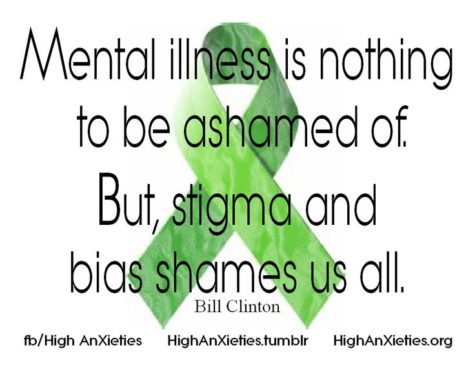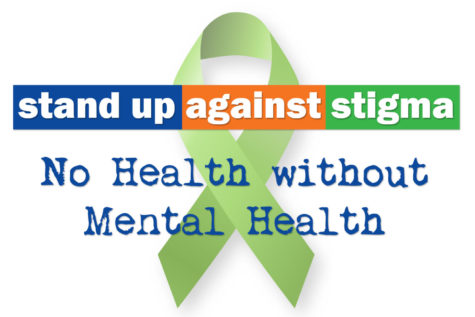Take A Stand Against Stigma
November 20, 2017
According to Mental Health America (MHA), “an estimated 54 million Americans suffer from some form of mental disorder in a given year.” This statistic alone does not account for the people who are too ashamed to seek help. If this many people are suffering from mental illness, why are people still so uneducated on the topic?
Mental illness by definition according to MHA is, “A disease that causes mild to severe disturbances in thought and/or behavior, resulting in an inability to cope with life’s ordinary demands and routines.” MHA states that there are more than 200 documented disorders. The most common disorders you could come across are depression, generalized anxiety disorder, obsessive-compulsive disorder, panic disorder, and schizophrenia. While it is common for someone to have a close friend or relative who suffers from one of these disorders, most people are not prepared to deal with the struggles that come with living with a mental disorder, whether they are the ones diagnosed or it is a loved one.
According to the National Alliance on Mental Illness (NAMI), “One in five youth live with a mental health condition, but less than half of these individuals receive needed services. Undiagnosed, untreated or inadequately treated mental health conditions can affect a student’s ability to learn, grow and develop.” Is it the fault of our own ignorance? Is it the fault of schooling? Or the fault of Hollywood’s constant false portrayal of mental disorder?
“People know little about mental disorders and believe the stereotypes are real because of Hollywood,” said, Emilia McQuillan, a Junior at Milford High School, “especially during Halloween when people with mental illnesses are made into crazy serial killers. Now when people think about mental illness they think of mental asylums and straight jackets.” Just as McQuillan stated, poor portrayals of mental illness and its treatment pervades so much of the media we consume, and you might not even notice it.
One movie, “Silver Linings Playbook,” features a man who suffers from bipolar disorder. Although the director had the best intentions, a disorder can not be ¨cured” with a little bit of love as is portrayed in the film. A more severe example would be “The Visit.” Although the idea of asylum patients escaping and portraying someone’s grandparents is scary and would draw anyone in, “The Visit” wrongly represents psychiatric patients. When we use mental illness to explain a villain’s motive, we harm the perception of mental illness as a whole. It instills a false sense of fear of mental illness into people. If the media continues to perpetuate mental illness as dangerous, people are going to continue to be less willing to seek help.
Stereotypes formed by movies or society in general are dangerous. They create false interpretations for disorders that students will face in their life. One of the most common stereotypes, as shown in “Silver Linings Playbook”, is that a disorder can be ¨cured¨ if a person just chooses to be happy or socializes more. Although there are treatments for most disorders, most of these treatments are prescribed by your doctor or therapy. Telling a person to “just be happy” or that they are only doing it for ¨attention¨ will not fix anything but make it worse. The best thing you can do for someone is to be there for them. The amount of youth dealing with mental illness are suspected to be on the lower side because people are afraid to seek help. If students make it a goal to become more educated and more open minded towards mental illness, it could create an environment where people are more comfortable talking about their struggles.
 People base their knowledge of mental health on what they see in movies and what they hear from other students because otherwise most, but not all, people are severely uneducated. In school they recognize the importance of physical education, a class that is required for most students to take, but fail to recognize the importance of mental health education.
People base their knowledge of mental health on what they see in movies and what they hear from other students because otherwise most, but not all, people are severely uneducated. In school they recognize the importance of physical education, a class that is required for most students to take, but fail to recognize the importance of mental health education.
At Milford High School our student services staff make it a goal of theirs to make students more aware. Milford High School’s student social worker, Mrs. Kerr, on the topic of Milford High’s mental health education says, ¨I think we can always use more; that certainly is a major goal of this hallway (student services) to promote awareness.” For the past five years Milford High School has brought in speaker Jeff Edwards to talk on the subject of suicide and mental illness and he’s had a lasting effect on many students. Kerr said that they are hoping to bring in another speaker in the winter to further bring awareness to Milford High School.
According to MHA in the years 2011 to 2014, the amount of youth with severe depression increased from 8.5 percent to 11.1 percent and even with severe depression, 80 percent are left with no or insufficient treatment. We live in a day in age where people are still left untreated and unprepared in the face of mental disorders. As a society it is our duty to not leave those struggling alone and helpless, but to make their health just as important and accepted as one’s physical health. Kerr had the perfect advice for someone who knows someone who is struggling or may be dealing with a mental health issue. “Feel free to ask for help if you need it, and be supportive of other students who may need counseling.” It’s time we take a stand together against the stigma and bias of mental illness.
